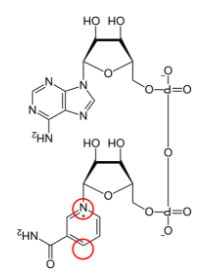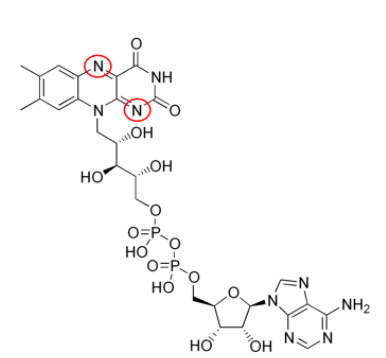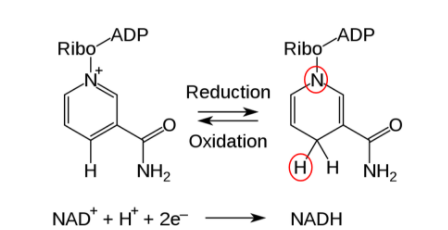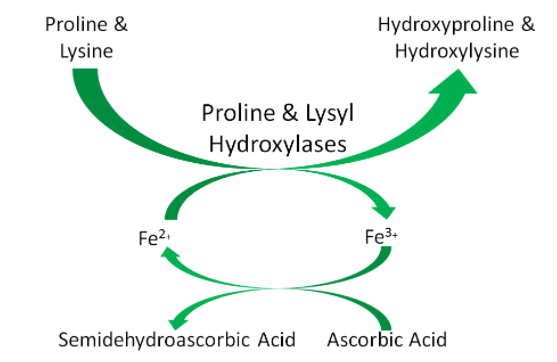17.1.1: Cofactors and Helpers in Metabolic Reactions
- Page ID
- 36326
Enzymes and Hormones Regulate Metabolism
The human body uses enzymes to facilitate many metabolic reactions. Several of these enzymes require cofactors to function; some textbooks refer to them as coenzymes. To keep things simple, we are including these coenzymes in our definition of cofactors. Cofactors can be either organic or inorganic molecules that are required by enzymes to function. Many organic cofactors are vitamins or molecules derived from vitamins. Most inorganic cofactors are minerals. Cofactors can be oxidized or reduced for the enzymes to catalyze the reactions.
Vitamin Cofactors - examples NAD and FAD
Two common cofactors that are derived from the B vitamins, niacin and riboflavin: they are nicotinamide adenine dinucleotide (NAD) and flavin adenine dinucleotide (FAD), respectively. The structure of NAD and FAD are shown below.

Figure 9.2.1 Structure of NAD1 upside down. The atoms are circled to help orient this structure with Figure 9.2.3

Figure 9.2.2 Structure of FAD2. The nitrogens are circled to help orient this structure with Figure 9.2.4
Both of these cofactors can be reduced; NAD is reduced to form NADH, while FAD is reduced to form FADH2 as shown in the 2 figures below.

Figure 9.2.3 The reduction of NAD to form NADH3

Figure 9.2.4 The reduction of FAD4 to FADH2
Accordingly, without adequate niacin and riboflavin in the diet, the coenzyme forms NAD + NAD+ and FAD would not be made in the body and metabolism would come to a stop,5 which in turn can lead to serious illness.
Mineral Cofactor - example 'iron' or Fe
An example of a mineral that serves as a cofactor is Fe2+ for proline and lysyl hydroxylases. We will discuss later in detail why vitamin C (ascorbic acid) is needed to reduce iron to Fe2+ so that it can serve as a cofactor for proline and lysyl hydroxylases.

Figure 9.2.5 Iron (Fe2+) is a cofactor for proline and lysyl hydroxylases
Hormones that support metabolic functions
|
Hormone |
Produced by | Type of Reaction | Control of Carbohydrate Metabolism | Control of Fat Metabolism | Control of Protein Metabolism | |
|
Cortisol |
Adrenal glands | Catabolic | Stimulates gluconeogenesis | In acute states, no effect. Chronically elevated levels lead to lipogenesis | Stimulates protein degradation | |
| Epinephrine | Adrenal glands | Catabolic | Stimulates glycogenolysis | Stimulates lipolysis | May stimulate protein degradation | |
| Glucagon | Pancreas | Catabolic | Stimulates glycogenolysis | Stimulates lipolysis | Stimulates protein degradation | |
| Insulin |
|
Anabolic | Stimulates glycogen synthesis | Stimulates lipogenesis | Stimulates protein synthesis |
Table 9.2 Major Hormones with influence on metabolism (modified from5)
Check your knowledge:
True or False: Enzymes catalyze metabolic reactions with the aid of cofactors, especially forms of niacin and riboflavin, as well as hormones such as insulin, glucagon, epinephrine, and cortisol.
True or False: Insulin and glucagon are produced in the pancreas, cortisol and epinephrine are produced in the adrenal glands.
Contributors
References & Links
- en.Wikipedia.org/wiki/File:NAD%2B_phys.svg
- en.Wikipedia.org/wiki/File:Fl...nucleotide.png
- en.Wikipedia.org/wiki/File:NA..._reduction.svg
- en.Wikipedia.org/wiki/File:FA...equlibrium.png
- Blake, J. S., Munoz, K. D., & Volpe, S. (2019). Nutrition: From Science to You (4th ed.). Pearson.

